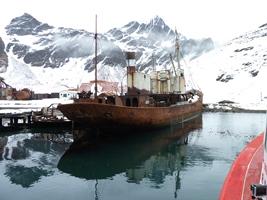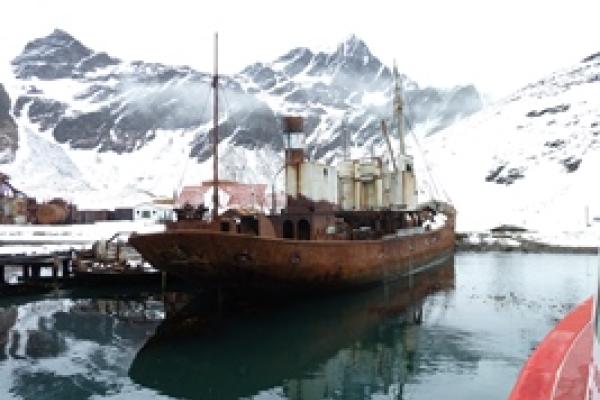
Patrick Britton
Published: September 01, 2017
Image


“Viola” is an Edwardian era British steam trawler currently beached at Grytviken on the remote South Atlantic island of South Georgia. One of only four surviving British vessels to have seen active service in the First World War,1 she was requisitioned by the Admiralty in 1914 for use as an armed trawler. A UK charity, the Viola Trust, aims to raise the funds needed to return “Viola” to her home port of Hull, and to restore her as a museum and a memorial to the vital contribution of coastal communities to the war effort. This article is a brief account of “Viola’s” unique history.
The advent of steam railways and steam trawlers allowed cheap and fast distribution of fresh fish to Great Britain’s growing industrial population, and sometime between the 1840s and the 1870s fish and chips became the UK’s national dish. ‘Boxing’ was an early method of intensive fishing, where trawler crews packed the newly caught fish in boxes which were then transferred to fast steam cutters, which rushed the catch to Hull and other docks including London’s Billingsgate Market. Tokens attached to the boxes meant each vessel was paid for the fruits of its own labour. In September 1905 Charles Hellyer, Managing Director of the Hellyer Steam Fishing Company and Hull’s leading trawler owner, announced plans to build a new North Sea boxing fleet of 50 ships, and placed orders for a total value of £450,000 (equivalent to £50 million today). The bulk of Hellyer’s order was won by the Grovehill shipyard of Cook, Welton & Gemmell at Beverley in the East Riding of Yorkshire. All the vessels in the Hellyer fleet were named after characters from the plays of William Shakespeare and yard number 96 was named “Viola” after the heroine of Twelfth Night.
A flush-decked vessel of 173 gt with a length overall of 108 ft and a beam of 21 ft, “Viola” had little superstructure other than the raised engine room casing and small open bridge. After her launch in January 1906, she was towed downriver to Hull to have her coal-fired boiler and triple expansion engine fitted by Amos & Smith. “Viola” was crewed by a skipper, mate, bosun, three deckhands, first and second engineers, fireman and cook. On joining the Hellyer fleet she was assigned the identification H868.
While previous boxing fleets had taken years to assemble, short delivery dates meant Hellyer's new fleet of 50 vessels was ready in just five months. The fleet’s first sailing on 20 February 1906 was a rare spectacle and a proud day for Hull. From then until 1914, it was constantly at sea, shooting, towing and hauling the nets, gutting and packing the catch, and rowing the fish boxes to the five steam cutters. Individual trawlers returned to port every five to six weeks for crew leave, new bunkers and provisions. The fleet operated in all weather and six trawlers and their crews were lost in storms prior to the First World War.
While the Hellyer family was forming its ambitious new trawler fleet, the Royal Navy was building its new revolutionary all-big-gun steam turbine battleship. HMS "Dreadnought" was launched at Portsmouth three weeks after "Viola" was launched at Beverley. With her armament of ten 12-inch guns, displacement of 17,900 gt and maximum speed of 21 knots, she overturned all the long-established principles of compromise in naval architecture. Her superiority was so obvious that all naval powers were forced to build new battleships to the same design, exacerbating the naval arms race between Great Britain and Imperial Germany. Ultimately the British Navy was able to maintain numerical superiority but only at exorbitant cost. When the war began, rather than risk its High Seas Fleet in an encounter with the superior strength of the British Grand Fleet, Germany decided to rely on two principal methods of offence, mines and submarines.
Having concentrated on winning the race to build capital ships, the Royal Navy lacked sufficient small craft to deal with such threats, especially since its destroyers were required as screens for the battleship and cruiser squadrons. However, the UK had the world’s largest merchant fleet and fishing vessels were well suited to minesweeping and patrol work, being handy in a seaway, drawing little water and carrying small crews. In 1910 the Royal Navy Reserve formed a trawler section and made arrangements with leading trawler owners to hire their vessels when required. Their crews were given training in minesweeping duties. By the outbreak of war, 146 trawlers were part of this scheme but many more had to be hired along with whalers, drifters, steam-yachts, paddle-steamers and motor-boats. These small ships would ultimately number nearly 4,000 and evolve into a supplementary fleet, the Auxiliary Patrol. Manned by up to 50,000 merchant seaman, fisherman, yachtsmen and naval enthusiasts, it kept open the seaways around the British Isles so that the mercantile marine could continue to move vital food and raw materials to Great Britain.
When “Viola” was requisitioned in mid-September 1914, her trawling gear was removed and she was armed with a 3-pounder gun. As His Majesty’s Trawler “Viola”, with Admiralty designation 614, she was sent to the Shetland Isles as part of the Auxiliary Patrol. Her wartime crew were Hull trawlermen under skipper Charles Allum. Based at Lerwick or Scalloway, she operated in a unit consisting of 5 trawlers and a yacht and was engaged in boom duties – guarding the anti-submarine nets that stretched across the harbour entrances – or sent out on patrol searching for U-boats or minefields. In October 1915 the unit was transferred to the River Tyne and “Viola” was refitted with a 12-pounder gun, hydrophones and depth charges, which greatly improved her ability to hunt, chase and sink U-boats.
North Sea fishing continued during wartime but as single-boat operations rather than in fleets. Losses were high as the unarmed trawlers were easily destroyed by U-boats, mostly with guns or explosives in order to save torpedoes. Trawler crews were usually allowed to escape in their rowing boats. By the middle of 1916 the active fishing fleet had been decimated. As the owners were reluctant to order replacements during wartime, the Admiralty began ordering armed trawlers direct from shipyards. Crew shortages meant fishermen in their 70s and 80s returned to sea.
HMT “Viola” had an eventful war. In 1917 she exchanged fire with a U-boat shelling a Norwegian steamer and successfully drove it off, and helped to rescue the crew of a coal barge driven ashore near Scarborough, actions for which Charles Allum was later Mentioned in Dispatches. In 1918 “Viola” and her group of armed trawlers hunted and destroyed two enemy submarines, UB-30 and UB-115. The latter was sighted by the airship R29 which dropped two bombs, the only recorded success by any British rigid airship in wartime. “Viola” was released from Admiralty service in February 1919.
The Hellyer Steam Fishing Company did not reconstitute its boxing fleet after the war and the company was liquidated in 1919. From a fleet of 47 vessels at the start of the war, 22 were lost – four on Admiralty service and 18 while fishing. The Hellyer family decided to sell off their surviving fleeting trawlers and instead concentrate on deep water fishing. In 1920 “Viola” was sold to Norwegian interests, renamed “Kapduen” and then “Dias”, and later converted to a whale catcher for expeditions off the Angolan coast. The modifications included the installation of a harpoon platform on her bow and moving the bridge to a position forward of the funnel, radically changing her appearance.
In 1927 “Dias” was sold to Compañia Argentina de Pesca SA and moved to Grytviken where she was used to hunt elephant seals, as well as for expedition and exploratory work. Her relocation to Antarctica saved her from the fate of her surviving sisters, many of which were either wrecked or sunk by enemy action in the Second World War, or scrapped. After “Dorcas” was scrapped in Spain in 1973 “Dias” / ”Viola” became the sole survivor of the Beverley-built Hellyer vessels. She underwent further modifications in the 1950s when her old bridge was replaced with a less attractive modern one, and her steam engines were converted to burn oil instead of coal.
When Pesca transferred its whaling interests to the British Company Albion Star in 1960 “Dias” returned to the British flag. She was laid up at the whaling station jetty in King Edward Cove when Grytviken station closed 1964 together with a vessel named “Albatros”. After the last caretaker left in 1971, the two ships were left to the elements and sank at their mooring under the weight of accumulated snow in 1974.
In March 1982 an early action of the Falklands War took place at Grytviken after a group of Argentine scrap metal merchants landed there, ostensibly to scrap “Dias” and other equipment, but whose landing party included Argentine special forces. Later in the conflict there were echoes of 1914 when Cumberland Bay became a major British transhipment base and five requisitioned Hull trawlers (“Cordella”, “Farnella”, “Junella”, “Northella” and “Pict”) anchored in the Bay, along with Cunard’s “Queen Elizabeth 2”.
In the late 1980s a major environmental clean-up of the South Georgia whaling stations was undertaken, and in 1991 the former whaling station manager’s house at Grytviken opened as the South Georgia Museum. “Dias” was refloated and beached in 2004, and her funnel was removed for safety reasons. It is hoped that £1.75 million can be raised in order to bring the ship home to Hull for restoration, repeating the successful salvage in 1970 of Isambard Kingdom Brunel’s “Great Britain” of 1843 from Sparrow Cove in the Falkland Islands, now fully restored at Bristol. Further information including how to donate is available on the Viola Trust’s website: www.violatrawler.net.2
1 Along with the light-cruiser HMS “Caroline” and monitor HMS “M33”, preserved at Belfast and Portsmouth respectively; Flower class sloop HMS “President”, which was permanently moored on the Thames Embankment from 1922 to 2016, is currently at Chatham and, lacking funding, is close to being scrapped.
2 See also Robinson R and Hart I, “Viola” The Life and Times of a Hull Steam Trawler (Lodestar Books, 2014).
3Photograph of “Dias” (ex-“Viola”) at Grytviken in 2016 courtesy of Solis Marine Consultants


